Symbolic Cemetery at Treblinka
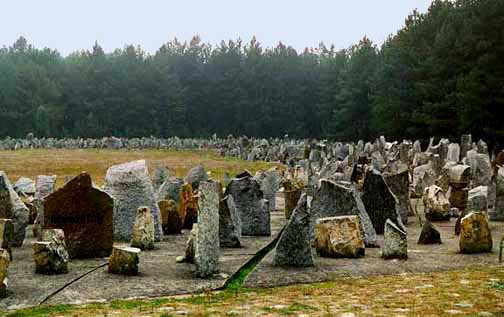
17,000 stones set in
concrete in a circle form a symbolic cemetery
Located on a knoll, at the top of a gentle
slope, on the site of the former Treblinka extermination camp
is a large circular area with 17,000 stones of various sizes
and colors set into concrete, which represents a symbolic cemetery.
When I visited Treblinka in October 1998, my tour guide told
me that 130 of the stones have the names of the cities or towns
from which the victims were deported to the death camp. The guide told me that
many relatives of those who died here come to the symbolic cemetery
and are disappointed to find that their village is not named
on any of the stones.
According to a pamphlet which I purchased
at the Visitor's Center, "The great monument in Treblinka
is a homage of the Polish people to those ashes lie under the
concrete plates of the symbolic cemetery. It is one of the most
tragic monuments of martyrdom in Poland."
My tour guide informed me that the ashes
of the 800,000 people who were murdered here were dumped in this
area and are now hidden underneath the concrete of the symbolic
cemetery and by the grass and tiny flowers which cover the area.
One of the 17,000 symbolic stones represents
the city of Kielce in central Poland, where 42 Jews were killed
by a mob of Polish citizens in a pogrom on July 4, 1946, long
after the Nazi occupation had ended. Today Kielce is a modern
industrial city with a population of 210,000, located between
Warsaw and Krakow. In 1939, the Jewish population was around
25,000, although until the early 1800s, Jews were barred from
living in the city. After the 1946 pogrom, many of the 300,000
Polish Holocaust survivors fled Poland and settled in other countries.
In 1968 there was more violence against the Jews in Poland, and
almost all of the survivors were forced to leave.
Since my visit to Treblinka in 1998,
I have learned that some tour guides now tell visitors that the
number of 17,000 stones in the symbolic cemetery represents the
highest number of Jews that were gassed in a single day when
the camp was in operation. Others say that the number 17,000
represents the number of Jewish communities that were destroyed
in the Holocaust.
The photograph below shows the 26-foot
granite memorial stone, which was designed to resemble a tombstone.
It is located approximately on the spot where the gas chambers
once stood, according to my guide. This view was taken from the
front side of the memorial stone, and you can see some of the
stones of the symbolic cemetery behind it. The large crack down
the middle of the stone is part of the design. Note the votive
candles placed between the cracks and the flowers left at the
base.
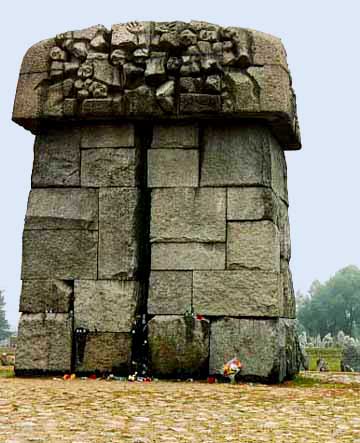 Front of stone monument
at Treblinka symbolic graveyard
Front of stone monument
at Treblinka symbolic graveyard
According to the pamphlet that I obtained
from the Visitor's Center, the Treblinka memorial site was built
between 1959 and 1963. In February 1960, the Warsaw Regional
Council selected the design of Polish sculptor Franciszek Duszenko
and Polish architect Adam Haupt for the memorial stone and the
Symbolic Cemetery.
According to the Council, the design
of the symbolic cemetery would create a field of jagged stones
that suggest a cemetery consisting of 17,000 stones with 700
of the stones inscribed with the names of the Jewish villages
and communities in Poland that were obliterated by the Holocaust.
The photograph below shows the back side
of the memorial tombstone. When the death camp was in operation,
there was a narrow dirt path through a "tube" covered
with tree branches which led to the gas chamber building in this
spot. Notice the Menorah at the top of the tombstone.
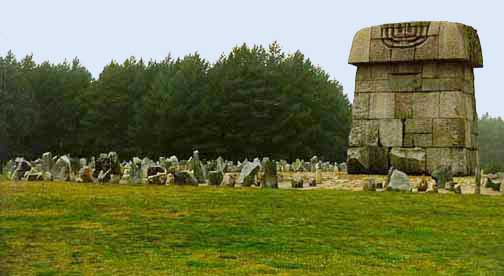 Back side of stone
monument, surrounded by symbolic grave stones
Back side of stone
monument, surrounded by symbolic grave stones
Raul Hilberg wrote in his three-volume
book entitled "The Destruction of the European Jews"
that there were 700,000 bodies buried at Treblinka, and 50,000
bodies taken directly from the gas chambers and burned on pyres.
The photo below shows more stones under
a majestic tree in the back portion of the symbolic cemetery,
behind a simulated cremation pit, which is visible in the foreground.
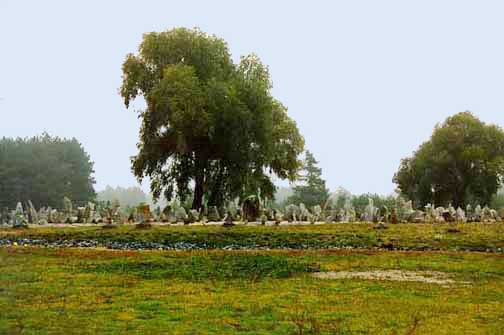 Symbolic cemetery with
simulated burning pit in foreground
Symbolic cemetery with
simulated burning pit in foreground
According to a map of the camp, the area on both sides of
the cremation pyre was where the 800,000 bodies were buried before
they were dug up and cremated.
The 800,000 bodies which had been previously
buried were dug up and then cremated on the orders of Reichsführer
Heinrich Himmler, after he visited the camp in 1943, according
to Martin Gilbert. This project required three months of intense
labor by 1,000 Jewish workers who were forced to perform this
grisly task in an attempt to destroy the evidence of mass murder
at Treblinka.
In the background of the picture below,
you can see four round containers where "eternal flames"
can be lit on special occasions.
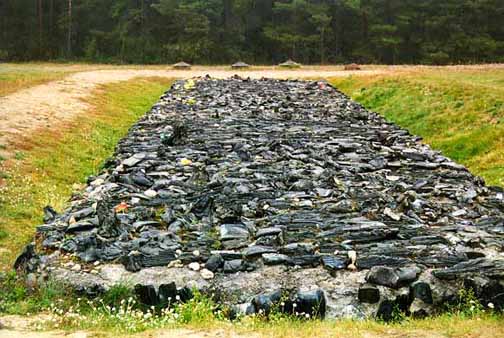 Memorial stones of
basalt recreate pits where bodies were burned
Memorial stones of
basalt recreate pits where bodies were burned
The photograph above represents the cremation
pit where, according to the camp pamphlet, bodies were burned
on "grates." The picture shows what the pamphlet calls
"melted basalt" set on a "concrete fundamental
plate."
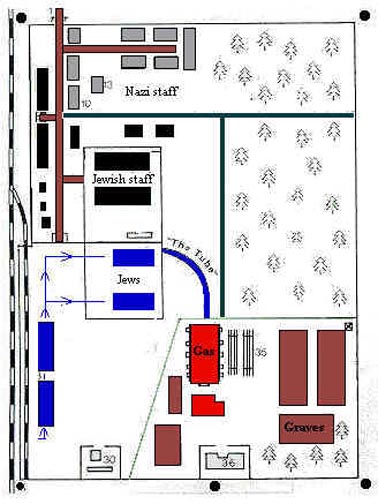 The top of the map
is South
The top of the map
is South
The map in the camp pamphlet, which is
similar to the map shown above, shows that there were actually
two cremation pyres, located just east of the 10 new gas chambers.
To the right of the spot where the train platform once stood,
and in front of you as you are looking into the camp with the
platform on the left, is the location of the "burial pits
for those who died during transportation," according to
the camp pamphlet. The victims were brought to the camp on trains
with freight cars, except for a few Very Important Jews, who
arrived in passenger cars.
Near the burial pits, according to the
pamphlet, was an "execution site (disguised as a hospital)."
This is where those who were too weak or sick to walk into the
gas chambers were shot and then buried in the pits, according
to the pamphlet. Half way up the gentle slope to where the symbolic
graveyard now stands, there were "3 old gas chambers"
according to the pamphlet, and a short distance to the south
of them were built "10 new gas chambers."
According to my tour guide, the first
gas chambers used carbon monoxide. The 10 new gas chambers used
the poison gas known as Zyklon-B, according to the pamphlet that
I purchased at the Visitor's Center. Treblinka apparently did
not have delousing chambers; all the clothing taken from the
prisoners was sent to the Majdanek camp to be disinfected with
Zyklon-B before being sent to Germany.
A short distance farther up the slope
to the east of the gas chambers was located the "cremation
pyres" according to a map in the camp pamphlet. None of
the three Operation Reinhard extermination camps had a crematorium
for burning the bodies of the 1.5 million Jews who were killed
in these camps. Of the other five extermination camps which were
in operation during the same period (Chelmno, Sobibor, Belzec,
Majdanek and Auschwitz-Birkenau), only Auschwitz-Birkenau and
Majdanek, which also functioned as forced labor camps, had crematoria
with ovens for burning the bodies.
This page was last updated on February
29, 2008
|